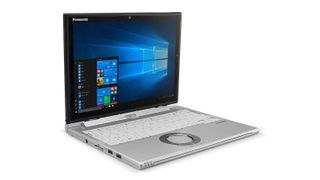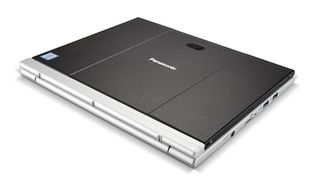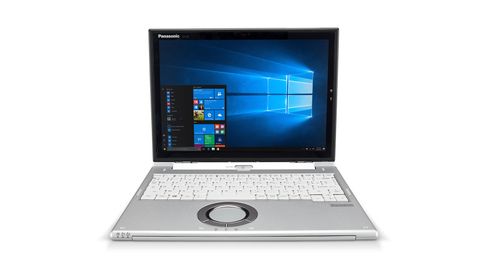Why you can trust TechRadar
Performance
While it doesn’t deliver all the power we’ve seen in Kaby Lake Core i5-7500U systems, the i5-7300U vPro is a decent CPU that offers a responsive platform.
In our battery tests using PCMark 8 in Work mode, it managed just over six hours of constant use before exhausting both internal and keyboard batteries.
Panasonic is a little coy about the size of the internal battery. But given that the company quotes 14 hours of use with it, and 6.5 hours without it, that would suggest the internal module is about 92% of the size of the external battery, or roughly 4800mAh.
So both power packs combined makes for 10,000mAh, a capacity that should give you a decent operating window depending on how wisely you use it. Lowering the screen brightness extended running time by at least an hour, in our experience.

The Intel HD Graphics 620 GPU might be fine for PowerPoint and YouTube playback, but it isn’t suitable for gaming or demanding 3D applications.
With a limited amount of storage space, USB 3.0 external storage is a necessary purchase for this machine. Because the 256GB drive provided won’t go that far, not once you’ve installed some applications and their associated data.
Before any of our test tools were in place the amount of usable space left was already lowered to around 160GB, as the SSD comes preinstalled with an un-activated copy of Office 365 and a selection of Intel and Panasonic utilities.
Here’s how the Panasonic Toughbook CF-XZ6 performed in our suite of benchmark tests:
Passmark: 2736
Passmark CPU: 5163
CPU-Z: 385.4 (single-thread); 877.9 (multi-thread)
Geekbench: 3184 (single-core); 6531(multi-core); 17298 (compute)
Cinebench: OpenGL: 38.04 fps; CPU: 208
CrystalDiskMark: 540.8 MBps (read); 526.6 MBps (write)
Novabench: 913
Atto: 544 MBps (read, 256mb); 510 MBps (write, 256mb)
Sisoft Sandra (KPT): 6.82
UserBenchmark (higher is better): 54.7
3DMark: Firestrike 877; Sky Diver 3663; Cloud Gate 6043
PCMark 8: Home 3200; Work 4128; Creative 4047; Battery 6 hrs 15 mins (Work test)
Benchmarks
The benchmark scores this hybrid achieved are very much in line with what we’d expect from an i5-7300U vPro system, with no significant surprises. The drive tests also demonstrate that this machine uses a SATA SSD and not one connected via a wider pathway.
The thin nature of the tablet makes it difficult for the processor to boost to 3.5GHz for any prolonged period due to heat build-up, delivering numbers that are distinctly middle-of-the-road.
Mistakes were made
The number of obvious mistakes that Panasonic made with this system is a concern. Since many of them are the very same ones that other hybrid manufacturers made long ago.
One classic hybrid problem is that the weight of the tablet part is much heavier than the keyboard, resulting in a lack of stability when you try to use touch. The CF-XZ6 simply rocks backwards or falls over when prodded.
This scenario could have been easily avoided had Panasonic considered a reversible hinge, or the ability to dock the tablet in reverse. The company did neither.
That leaves one practical alternative – detaching the tablet to use it held with one hand, except in doing so you’ve just waved goodbye to the majority of your battery capacity.
Given that the tablet apps you are most likely to run are games or video playback – i.e. apps that use lots of power – that’s very inconvenient.
The charging model is also a mess, as the charger needs a cable adapter to connect to both the tablet and the keyboard parts. Misplace this one short cable, and the PSU won’t be charging anything.
Another question to ask here is: why does this cable even exist? Both parts use the same charging receptacle, so why doesn’t the PSU have the right connector on it by default?
The real kicker here is that the perfect solution was within Panasonic’s grasp – the USB Type-C port that it put on the tablet, yet foolishly omitted from the keyboard.
But the decision the company made with the biggest consequences for the CF-XZ6 is the screen it chose to use.
As tablet displays go, it’s reasonably sharp, and the color gamut is acceptable. There is obvious backlight leakage around the frame at the lower corners, but apart from that issue, it is serviceable.
The bigger problem with this panel is the 2160 x 1440 resolution, which is overkill for what’s a 12-inch panel corner-to-corner. Having too many pixels isn’t typically an issue, but it can become one if you like fast-moving graphics.

When you first run the machine, a warning pop-up appears to alert the owner that they might burn themselves with both the hot air exhaust and also the IR-LED emitters for the Windows Hello sensor.
In respect of the hot air ventilation, this isn’t just a health and safety overreach; it’s a valid warning.
Play a typical tablet game like Bubble Ghost or Angry Birds for about 15 minutes, and the tablet gets very warm to the touch, and the vented air is noticeably hot.
The culprits are likely the limited capabilities of the integrated Intel GPU, and the very slim form factor of the tablet which doesn’t allow for sufficient air exchange. Forcing this GPU to drive a 2160 x 1440 display makes the situation worse, as this has 50% more pixels than a 1080p panel, exerting an equivalent extra strain on the graphics solution.
The power consumption is so high in these situations that Panasonic even put a switch on the keyboard to disable recharging the keyboard-side battery, presumably because there aren’t enough amps coming into the system to recharge both batteries and work hard (play games) simultaneously.

Final verdict
Panasonic engineers dropped the ball with the ToughBook CF-XZ6, managing to create a hybrid design that isn’t good at being a laptop, and is also rather poor at being a tablet.
The best aspects of this design are the performance of the Kaby Lake processor, and the decent number of USB Type-A ports on the keyboard section.
For those capabilities – plus the ability to handle a 76cm freefall drop test and being sat on by a person weighing 220lbs – the price is also on the excessive side.
- We’ve highlighted the best business laptops of 2017
Mark is an expert on 3D printers, drones and phones. He also covers storage, including SSDs, NAS drives and portable hard drives. He started writing in 1986 and has contributed to MicroMart, PC Format, 3D World, among others.


